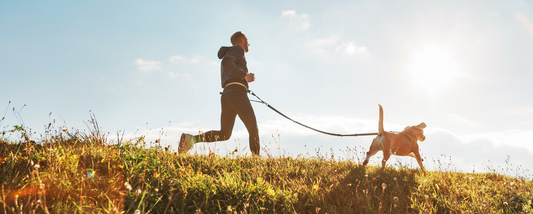Fall is a great time to get out of the house and exercise with your dog. The cool weather is ideal for long walks, leaf-peeping hikes, and epic games of fetch. As you venture out into the wild outdoors (or you know, your own backyard) keep these common Fall hazards in mind in order to keep your pup safe and happy all season long.
Yard Work: It may be tempting keep your dog with you while you clear the yard of leaves, but proceed with caution. Much like fireworks, the startling noise of a leaf blower has been known to send dogs sprinting in all directions. Keep a close watch on your dog if he or he is on the skittish side, especially if your yard is open to the street. Additionally, stagnant piles of leaves contain all kinds of nasty bacteria. They’re fine to play in, but if ingested, they can cause serious problems. Don’t let you dog crunch on dead leaves or he could accidentally make himself sick.
Poison Plants: Speaking of sick puppies, the Fall season brings about some innocuous-looking new plants that are very dangerous for dogs and humans. Two of the biggest offenders in the Fall are red maple leaves, wild mushrooms and fallen chestnuts aka “conkers”. Scour your yard for any potential offenders and try to keep an eye on what your dog is up to. Signs of poisoning in dogs include vomiting, diarrhea, weakness, lethargy, excessive drooling, and lack of coordination. Call your vet immediately if your dog exhibits any of these signs after ingesting an unknown plant or save this Pet Poison Helpline in your phone: 800-213-6680.
Shorter Days: Since less sunlight means more walks in the dark, Fall tragically brings about an increase in car-related deaths in both dogs and cats. Please remember to keep your dog on a leash when walking in the dark. Post-work commuters may not see you on the side of the road as well as they did during the summer months. A bright, reflective safety harness and our remote LED light are both good ideas to help drivers see your pet when the days become shorter.
Vermin: You may notice an increase in the number of field mice scampering around as the weather gets colder. That’s because Fall is a busy time for rodents of America who are searching for shelter and preparing for the cold winter ahead. If your dog is pray driven, keep him or her on a leash whenever possible. Mice and rats carry a variety of diseases such as salmonella, Hantavirus, leptospirosis, “rat-bite fever”. Additionally, rodenticides are more common in the Fall, which are almost as poisonous to dogs as they are to rodents. Heed signs that warn of baited and treated areas and steer clear!
Allergies: Humans aren’t the only ones that sniffle and sneeze when the leaves start to Fall. Dying plants and windy days stir up a lot of pollen, plant matter, and other irritants that can bother your pup’s sensitive nose. Any dog with an inhibited respiratory system such as bulldogs, Frenchies, and other flat-nosed breeds are particularly prone to allergies. Coughing, wheezing, sneezing, watery eyes, excessive paw licking, rashes, and scratching are all signs that your dog may be suffering from fall allergies. If left untreated, allergies could lead to painful medical conditions so ask your vet for a canine antihistamine if your dog appears uncomfortable. At home remedies that can help milder symptoms include baths with oatmeal shampoo, frequent brushing to keep their coats free of irritants, and adding yucca or coconut oil— both natural anti-inflammatories—to your dog’s diet in small doses.
Although these are some of the most common problems Vets deal with during the Autumn months, each one is easily avoidable with a little effort. Share this article to help keep your four-legged friends safe all season long.





